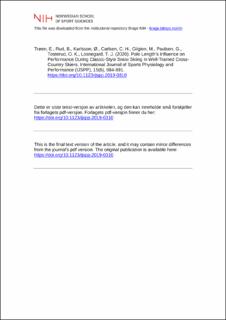| dc.contributor.author | Trøen, Erik | |
| dc.contributor.author | Rud, Bjarne | |
| dc.contributor.author | Karlsson, Øyvind | |
| dc.contributor.author | Carlsen, Camilla Høivik | |
| dc.contributor.author | Gilgien, Matthias | |
| dc.contributor.author | Paulsen, Gøran | |
| dc.contributor.author | Tosterud, Ola Kristoffer | |
| dc.contributor.author | Losnegard, Thomas Johansen | |
| dc.date.accessioned | 2021-02-10T10:58:26Z | |
| dc.date.available | 2021-02-10T10:58:26Z | |
| dc.date.created | 2020-11-03T15:11:16Z | |
| dc.date.issued | 2020 | |
| dc.identifier.citation | International Journal of Sports Physiology and Performance (IJSPP). 2020,15 (6), 884-891. | en_US |
| dc.identifier.issn | 1555-0265 | |
| dc.identifier.uri | https://hdl.handle.net/11250/2727152 | |
| dc.description | I Brage finner du siste tekst-versjon av artikkelen, og den kan inneholde ubetydelige forskjeller fra forlagets pdf-versjon. Forlagets pdf-versjon finner du på humankinetics.com / In Brage you'll find the final text version of the article, and it may contain insignificant differences from the journal's pdf version. The definitive version is available at humankinetics.com | en_US |
| dc.description.abstract | Purpose: To investigate how self-selected pole length (PL) of ∼84% (PL84%) compared with ∼90% (PL90%) of body height influenced performance during a 700-m time trial with undulating terrain on snow. Methods: Twenty-one cross-country skiers, 7 of whom were women, performed 4 trials at a maximal effort in a counterbalanced fashion with PL84% and PL90% separated by 20-minute breaks between trials. In trials I and II, only double poling was allowed, while in trials III and IV, skiers used self-selected classical subtechniques. Continuous speed, cyclic parameters, and heart rate were collected using microsensors in addition to a post-time-trial rating of perceived exertion (RPE). Results: The 700-m times with only double poling were significantly shorter with PL90% than PL84% (mean ± 95% confidence limits –1.6% ± 1.0%). Segment analyses showed higher speed with PL90% in uphill sections than with PL84% (3.7% ± 2.1%), with the greatest difference found for the female skiers (5.6% ± 2.9%). In contrast, on flat terrain at high skiing speeds, speed was reduced with PL90% compared with PL84% (–1.5% ± 1.4%); this was only significant for the male skiers. During free choice of classical subtechniques, PL did not influence performance in any segments, choice of subtechnique, or cycle rate during the trials. No differences in rating of perceived exertion or heart rate between PLs were found. Conclusions: PL90% improved performance in uphills at low speeds when using double poling but hindered performance on flat terrain and at higher speeds compared with self-selected PLs. Choice of PL should, therefore, be based on racecourse topography, preferred subtechniques, and the skier’s physiological and technical abilities. | en_US |
| dc.language.iso | eng | en_US |
| dc.subject | GNSS | en_US |
| dc.subject | equipment | en_US |
| dc.subject | rating of perceived exertion | en_US |
| dc.subject | skiing technique | en_US |
| dc.title | Pole Length’s Influence on Performance During Classic-Style Snow Skiing in Well-Trained Cross-Country Skiers | en_US |
| dc.type | Peer reviewed | en_US |
| dc.type | Journal article | en_US |
| dc.description.version | acceptedVersion | en_US |
| dc.source.pagenumber | 884-891 | en_US |
| dc.source.volume | 15 | en_US |
| dc.source.journal | International Journal of Sports Physiology and Performance (IJSPP) | en_US |
| dc.source.issue | 6 | en_US |
| dc.identifier.doi | 10.1123/ijspp.2019-0310 | |
| dc.identifier.cristin | 1844595 | |
| dc.description.localcode | Institutt for fysisk prestasjonsevne / Department of Physical Performance | en_US |
| cristin.ispublished | true | |
| cristin.fulltext | postprint | |
| cristin.qualitycode | 1 | |
